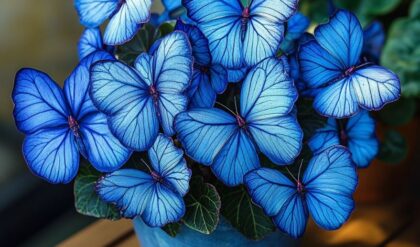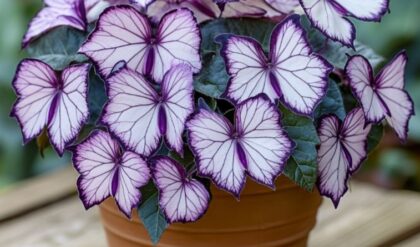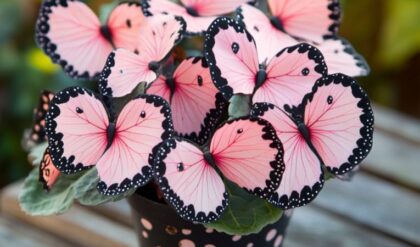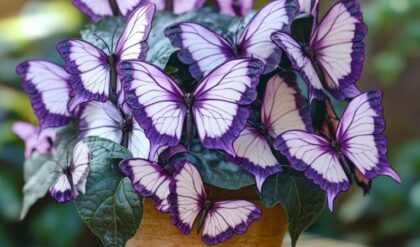Angel Leaf Begonia, with its gracefully cascading leaves and vibrant foliage, is a captivating houseplant that can transform any indoor space into an oasis of elegance. These plants, known for their distinct wing-like leaves, are not just visually appealing but also relatively easy to care for. This comprehensive guide will walk you through the intricacies of cultivating healthy, thriving Angel Leaf Begonias, unlocking the secrets to their care and helping you create a stunning display in your home.
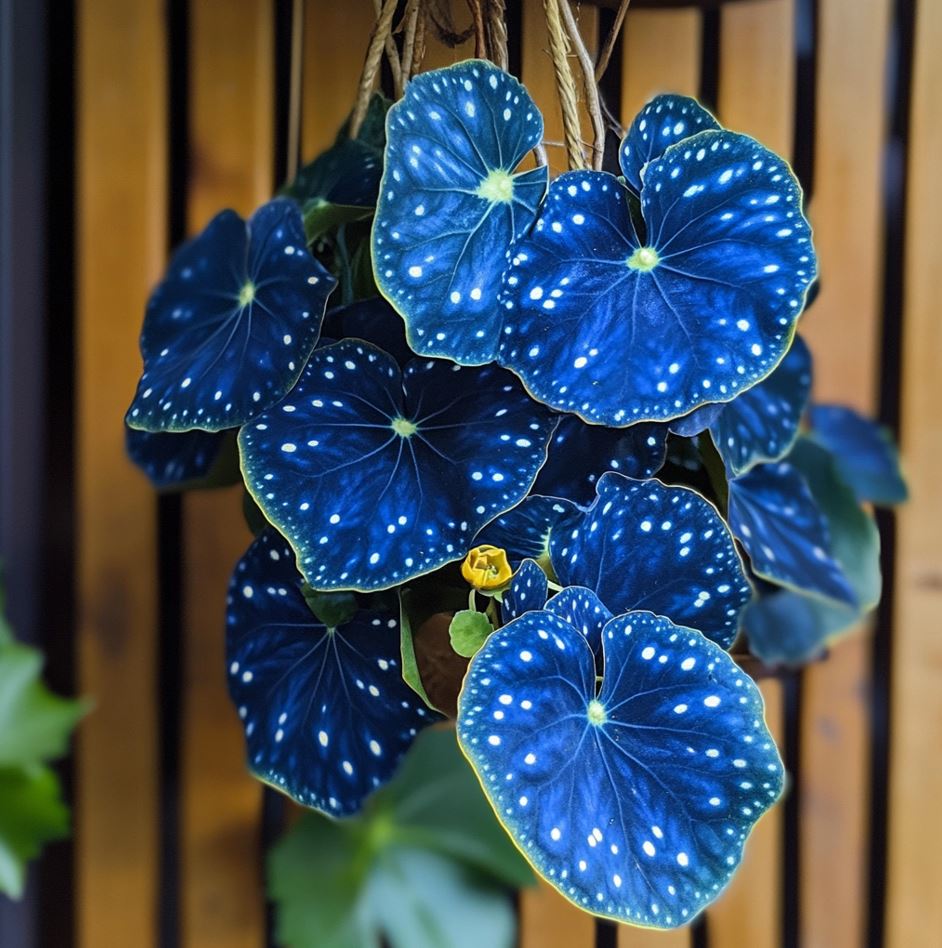
Understanding the Angel Leaf Begonia
The Angel Leaf Begonia, scientifically known as Begonia ‘Angel Wing’, is a popular variety of begonia prized for its unique foliage and adaptability to indoor environments. Before diving into the specifics of care, it’s essential to understand the nature of this plant and what makes it so special.
The Origins and Characteristics of Angel Leaf Begonia
Angel Leaf Begonias are hybrid plants, resulting from the crossbreeding of cane-like begonias. They inherit the best traits from their parent plants, combining the upright growth of cane begonias with the attractive foliage of other varieties. The result is a plant that’s both structurally interesting and visually stunning.
These begonias are characterized by their wing-shaped leaves, which can grow up to 6 inches long. The foliage often features deep lobes and serrated edges, giving them a distinctive appearance. While the green varieties are most common, you can find Angel Leaf Begonias in a range of colors, including silver, bronze, and even pink-tinged varieties.
One of the most captivating features of Angel Leaf Begonias is the intricate veining on their leaves. These veins create a mesmerizing pattern that adds depth and texture to the plant’s overall appearance. The undersides of the leaves are often a contrasting color, usually a deep red or purple, adding another layer of visual interest.
The Growth Habits of Angel Leaf Begonia
Angel Leaf Begonias are known for their cascading growth habit. As they mature, they develop long, arching stems that can reach up to 2-3 feet in length. This makes them ideal for hanging baskets or elevated planters where their trailing stems can be showcased to full effect.
While they’re primarily grown for their foliage, Angel Leaf Begonias do produce flowers. The blooms are typically small and delicate, appearing in clusters. They can range in color from white to pink to red, depending on the variety. However, it’s worth noting that the flowers are often considered secondary to the plant’s stunning foliage.
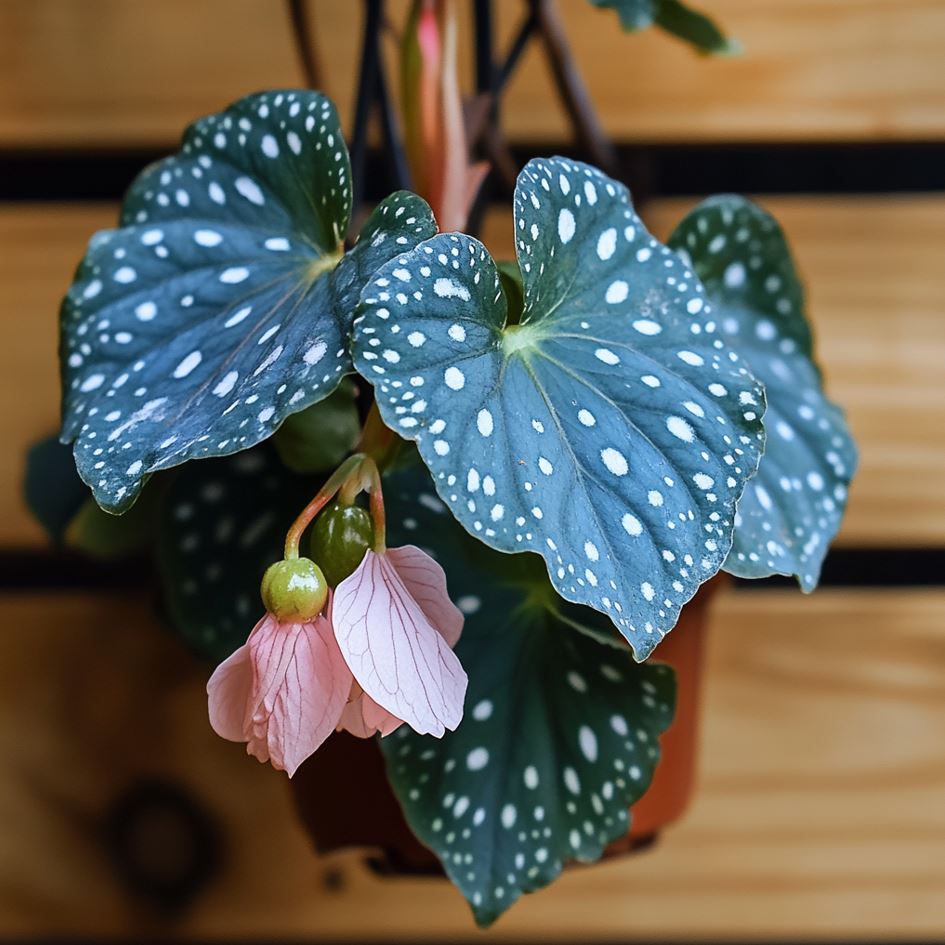
These begonias are evergreen, meaning they retain their leaves year-round when grown indoors. In optimal conditions, they can grow relatively quickly, filling out a pot or basket within a single growing season. This rapid growth, combined with their eye-catching appearance, makes them a popular choice for gardeners looking to make a big impact in a short amount of time.
The Benefits of Growing Angel Leaf Begonia
Beyond their aesthetic appeal, Angel Leaf Begonias offer several benefits to indoor gardeners. They’re known for their air-purifying qualities, helping to remove toxins from the air and improve indoor air quality. This makes them not just a beautiful addition to your home, but a healthy one as well.
Additionally, Angel Leaf Begonias are relatively low-maintenance compared to some other houseplants. They’re forgiving of the occasional missed watering and can adapt to a range of light conditions. This makes them an excellent choice for beginner gardeners or those who want a stunning plant without the high-maintenance care requirements.
Lastly, these begonias can be easily propagated, allowing you to expand your collection or share plants with friends and family. This not only makes them a cost-effective choice but also adds an element of satisfaction as you watch your propagated plants grow and thrive.
Creating the Ideal Environment for Your Angel Leaf Begonia
To ensure your Angel Leaf Begonia thrives, it’s crucial to create an environment that mimics its natural habitat as closely as possible. This involves considering factors such as light, temperature, humidity, and placement within your home.
Finding the Perfect Light Conditions
Light is one of the most critical factors in the health and growth of your Angel Leaf Begonia. These plants prefer bright, indirect light, which can be a bit tricky to achieve in some homes. Here’s how to ensure your begonia gets the light it needs:
Bright, indirect light is key for Angel Leaf Begonias. This means they should be placed in a location where they receive plenty of light throughout the day, but not direct sunlight that can scorch their delicate leaves. An east-facing window is often ideal, as it provides gentle morning sun and indirect light for the rest of the day.
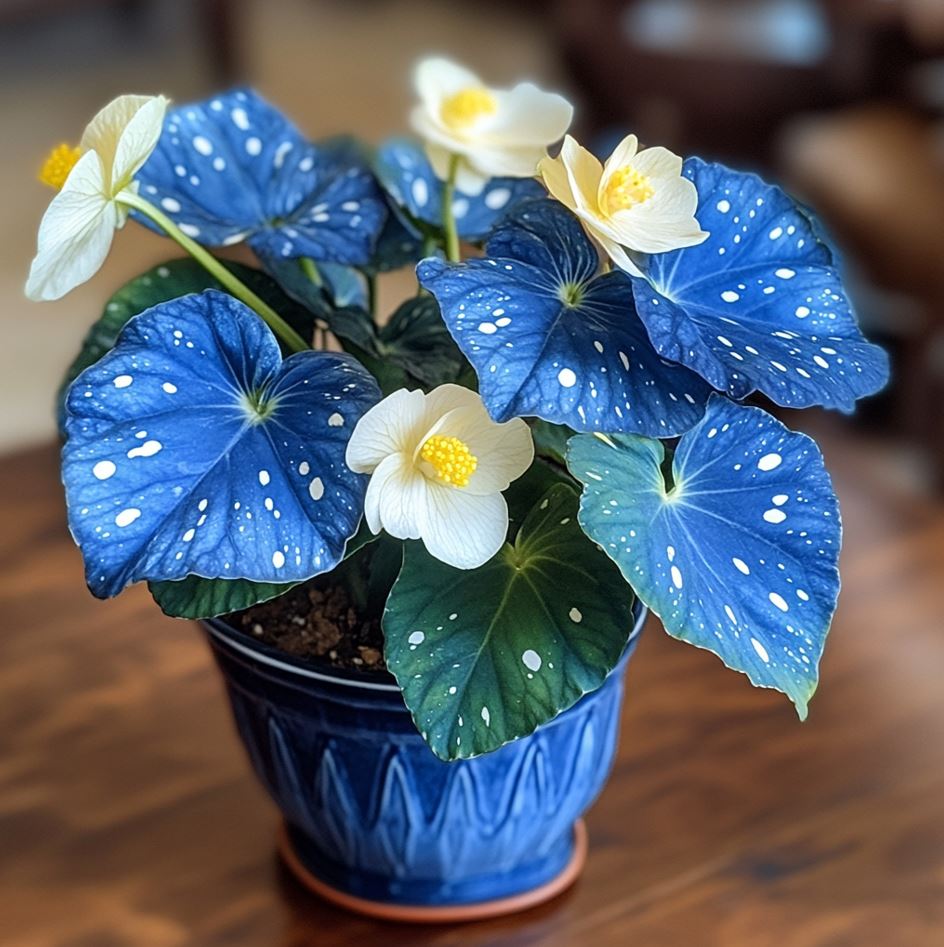
If you don’t have an east-facing window, don’t worry. Angel Leaf Begonias can adapt to other locations with a bit of care. A north-facing window can work well, especially if it’s a large window that lets in plenty of light. For west or south-facing windows, you may need to provide some protection from the intense afternoon sun. This can be achieved by placing a sheer curtain over the window or moving the plant a few feet away from the direct light.
It’s important to note that while Angel Leaf Begonias need bright light to thrive, they can tolerate lower light conditions better than many other plants. However, in lower light, you may notice slower growth and less vibrant foliage colors. If you notice your begonia’s stems becoming leggy or stretched out, it’s a sign that it’s not receiving enough light and should be moved to a brighter location.
Maintaining the Right Temperature
Angel Leaf Begonias are tropical plants, and as such, they prefer warm temperatures. The ideal temperature range for these plants is between 65-75°F (18-24°C). Fortunately, this aligns well with the comfortable temperature range for most homes, making them easy to accommodate.
However, it’s important to protect your Angel Leaf Begonia from temperature extremes. They don’t tolerate cold well, so keep them away from drafty windows or doors in the winter. Similarly, while they enjoy warmth, excessive heat can be detrimental. Avoid placing them near heat sources like radiators or air conditioning vents.
Temperature consistency is also key. Sudden temperature fluctuations can stress the plant, leading to leaf drop or other issues. Try to maintain a relatively stable temperature in the area where your begonia is placed.
Creating the Right Humidity Levels
As tropical plants, Angel Leaf Begonias appreciate a humid environment. While they can tolerate average household humidity levels, they’ll truly thrive in higher humidity. Here are some ways to increase humidity for your begonia:
- Use a pebble tray: Place your begonia pot on a tray filled with pebbles and water. As the water evaporates, it increases the humidity around the plant.
- Group plants together: Placing several plants close to each other naturally increases the humidity in that area.
- Mist regularly: Lightly misting the leaves of your begonia can help increase humidity. However, be careful not to overdo it, as constantly wet leaves can lead to fungal issues.
- Use a humidifier: If you live in a particularly dry climate, a small room humidifier can be a great investment for your plants.
Remember, while Angel Leaf Begonias enjoy humidity, they also need good air circulation to prevent fungal diseases. Ensure there’s adequate space between plants and consider using a small fan to improve air movement if necessary.
Choosing the Right Location in Your Home
When deciding where to place your Angel Leaf Begonia, consider all the factors we’ve discussed – light, temperature, and humidity. Here are some ideal locations in most homes:
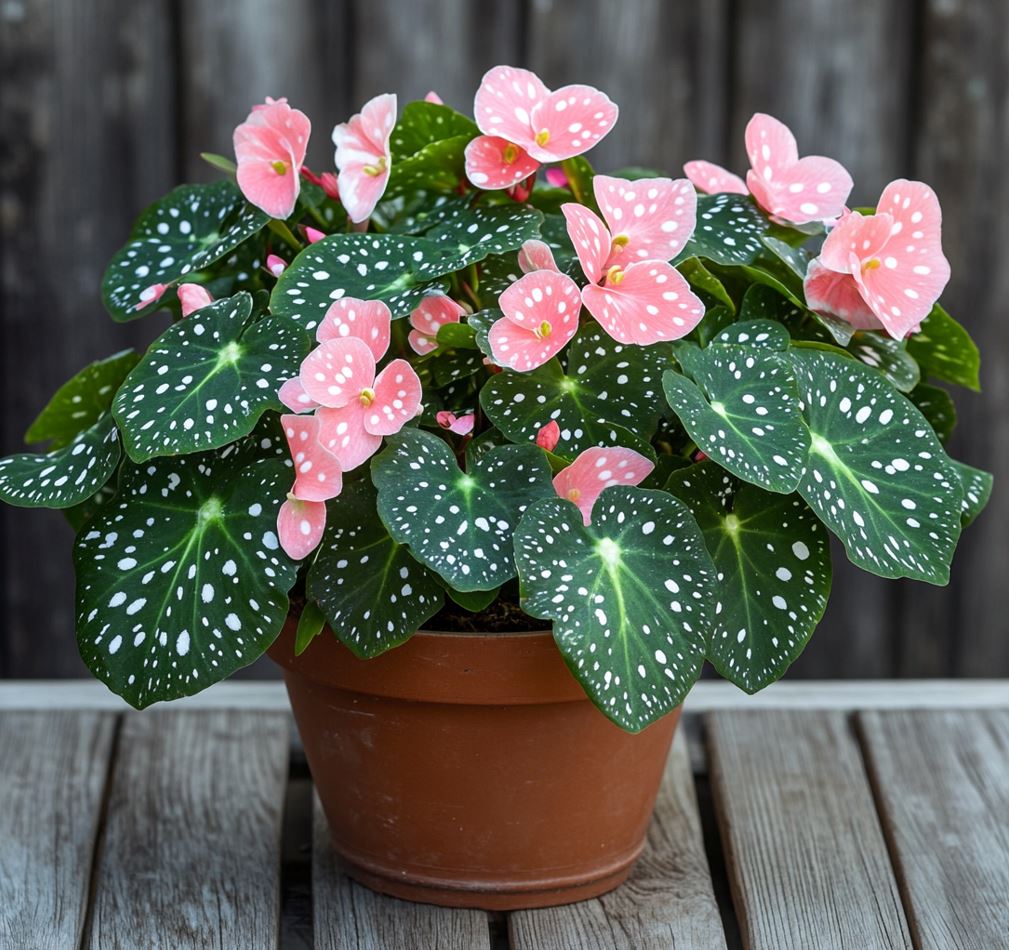
- Near an east-facing window in a room with stable temperatures.
- In a bathroom with a window, where humidity levels are naturally higher.
- In a kitchen away from heat sources, where it can benefit from increased humidity from cooking.
- In a bright corner of a living room, possibly grouped with other plants for increased humidity.
Remember, the perfect location may require some trial and error. Don’t be afraid to move your begonia if it’s not thriving in its current spot. Pay attention to its growth and leaf color, and adjust its location as needed to ensure it gets the ideal conditions for healthy growth.
Mastering the Art of Angel Leaf Begonia Care
Once you’ve set up the ideal environment for your Angel Leaf Begonia, the next step is to master the day-to-day care that will keep your plant healthy and thriving. This includes proper watering techniques, fertilization, pruning, and addressing common issues that may arise.
Perfecting Your Watering Technique
Watering is perhaps the most crucial aspect of caring for your Angel Leaf Begonia. These plants prefer consistently moist soil, but they’re susceptible to root rot if overwatered. Finding the right balance is key to keeping your begonia happy and healthy.
The golden rule for watering Angel Leaf Begonias is to allow the top inch of soil to dry out between waterings. This ensures that the plant receives enough water without sitting in soggy soil. To check the moisture level, simply stick your finger about an inch into the soil. If it feels dry at your fingertip, it’s time to water.
When you do water, do so thoroughly. Water until you see it running out of the drainage holes at the bottom of the pot. This ensures that water reaches all parts of the root system. After watering, empty any water that collects in the saucer beneath the pot to prevent the plant from sitting in standing water.
The frequency of watering will depend on various factors including the size of the plant, the size of the pot, the type of potting mix, and the environmental conditions. In general, you might find yourself watering once or twice a week during the growing season, and less frequently during the winter months when growth slows down.
It’s also worth noting that Angel Leaf Begonias prefer room temperature water. Cold water can shock the roots, while warm water can encourage fungal growth. If possible, use filtered water or leave tap water out overnight to allow chlorine to dissipate.
Fertilizing for Optimal Growth
Proper fertilization is essential for maintaining the lush, vibrant foliage that Angel Leaf Begonias are known for. These plants are moderate feeders and benefit from regular fertilization during their active growing season.
During spring and summer, feed your Angel Leaf Begonia every two to four weeks with a balanced, water-soluble fertilizer. Look for a fertilizer with equal parts nitrogen, phosphorus, and potassium (such as a 10-10-10 or 20-20-20 formula). Always dilute the fertilizer to half the recommended strength to avoid burning the plant’s delicate roots.
As autumn approaches and growth begins to slow, reduce fertilization to once a month. During the winter months, you can typically skip fertilizing altogether unless your plant is showing signs of active growth.
It’s important not to over-fertilize your Angel Leaf Begonia. Too much fertilizer can lead to salt build-up in the soil, which can damage the plant’s roots. If you notice a white crust forming on the soil surface, it’s a sign of fertilizer build-up. In this case, flush the soil thoroughly with water to wash away excess salts.
Pruning and Shaping Your Angel Leaf Begonia
Regular pruning is essential for maintaining the shape and health of your Angel Leaf Begonia. Pruning not only keeps the plant looking tidy but also encourages bushier growth and can help prevent disease by improving air circulation.
Here are some key points to remember when pruning your Angel Leaf Begonia:
- Remove any dead, damaged, or diseased leaves as soon as you notice them. This helps prevent the spread of disease and keeps the plant looking its best.
- Pinch off the growing tips of stems to encourage branching and create a fuller plant. This is especially useful for young plants or those that have become leggy.
- If your begonia becomes too tall or straggly, don’t be afraid to cut it back more severely. These plants respond well to hard pruning and will often come back bushier and more vibrant.
- Always use clean, sharp scissors or pruning shears to make clean cuts and minimize damage to the plant.
Remember to sanitize your pruning tools before and after use to prevent the spread of disease. You can do this by wiping the blades with rubbing alcohol.
Addressing Common Issues and Pests
While Angel Leaf Begonias are generally hardy plants, they can sometimes face issues. Being able to identify and address these problems quickly is key to maintaining a healthy plant.
- Yellowing leaves: This can be a sign of overwatering, underwatering, or nutrient deficiency. Check your watering routine and soil moisture levels first. If the issue persists, it might be time to fertilize.
- Brown leaf edges: This is often a sign of low humidity. Increase humidity around the plant using the methods discussed earlier.
- Leggy growth: If your begonia is becoming stretched out with long stems and sparse leaves, it’s likely not receiving enough light. Move it to a brighter location.
- Pests: Angel Leaf Begonias can sometimes be affected by common houseplant pests like mealybugs, spider mites, or aphids. Regularly inspect your plant, especially the undersides of leaves. If you spot pests, treat with insecticidal soap or neem oil.
- Fungal issues: If you notice spots on the leaves or a powdery substance, your begonia might have a fungal infection. Improve air circulation, avoid getting water on the leaves when watering, and treat with a fungicide if necessary.
Remember, prevention is often the best cure. Regular care, proper watering, and maintaining the right environmental conditions will go a long way in keeping your Angel Leaf Begonia healthy and pest-free.
Propagation and Repotting: Expanding Your Angel Leaf Begonia Collection
One of the joys of growing Angel Leaf Begonias is how easy they are to propagate. This allows you to expand your collection or share these beautiful plants with friends and family. Additionally, knowing when and how to repot your begonia is crucial for its long-term health and growth.
Methods of Propagation
Angel Leaf Begonias can be propagated through several methods, with stem cuttings being the most popular and reliable. Here’s a step-by-step guide to propagating your begonia through stem cuttings:
- Choose a healthy stem: Select a stem that’s about 4-6 inches long and has at least two leaves. Make sure the stem is green and pliable, not woody.
- Make the cut: Using clean, sharp scissors or pruning shears, make a clean cut just below a leaf node (where a leaf attaches to the stem).
- Remove lower leaves: Strip off the lower leaves, leaving only the top one or two sets of leaves.
- Prepare for rooting: You can root your cutting in water or directly in soil. For water rooting, simply place the cutting in a glass of clean water, ensuring that the leaf nodes are submerged. For soil rooting, dip the cut end in rooting hormone (optional but helpful) and plant it in a small pot filled with moist, well-draining potting mix.
- Provide proper care: Place your cutting in a warm spot with bright, indirect light. If rooting in water, change the water every few days to keep it fresh. If rooting in soil, keep the soil consistently moist but not waterlogged.
- Wait for roots: In about 2-3 weeks, you should see roots developing. Once the roots are about an inch long, you can transplant water-rooted cuttings into soil.
- Transplant: Once your cutting has developed a good root system, you can pot it up into a small container with fresh potting mix.
Another method of propagation is through leaf cuttings. This involves taking a healthy leaf with its petiole (leaf stem) intact, making a few small cuts on the main veins on the underside of the leaf, and laying it on moist potting mix. Secure the leaf to the soil with small pins or pebbles. In time, new plants will form at these cut points.
When and How to Repot Your Angel Leaf Begonia
Repotting is an important part of Angel Leaf Begonia care. These plants typically need repotting every 1-2 years, or when they outgrow their current container. Here are some signs that your begonia needs repotting:
- Roots are growing out of the drainage holes
- The plant dries out quickly, requiring more frequent watering
- Growth has slowed down significantly
- The plant looks too large for its current pot
When it’s time to repot, follow these steps:
- Choose a new pot: Select a pot that’s 1-2 inches larger in diameter than the current pot. Ensure it has adequate drainage holes.
- Prepare the new pot: Fill the bottom of the new pot with fresh, well-draining potting mix.
- Remove the plant: Gently remove the begonia from its current pot. If it’s root-bound, carefully loosen the roots with your fingers.
- Inspect the roots: Remove any dead or rotting roots with clean, sharp scissors.
- Plant in the new pot: Place the plant in the new pot and fill around it with fresh potting mix. The plant should be at the same depth it was in the old pot.
- Water thoroughly: After repotting, water the plant well and allow it to drain.
- Aftercare: Place the newly repotted plant in a shaded area for a few days to allow it to adjust before moving it back to its usual spot.Conclusion
In conclusion, taking care of your Angel Leaf Begonia involves understanding its needs and addressing any issues that may arise. By being vigilant about signs of distress, propagating your plants correctly, and knowing when to repot, you can create a thriving environment for your begonias. Regular attention to watering, humidity, light levels, and pest management will ensure your plants not only survive but flourish. With the right care, your Angel Leaf Begonia will be a stunning addition to your plant collection, offering beauty and joy for years to come. Embrace the journey of nurturing these delightful plants, and watch as they reward you with their vibrant foliage and unique charm.

